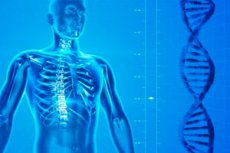New publications
How do you identify cancer from DNA?
Last reviewed: 29.06.2025

All iLive content is medically reviewed or fact checked to ensure as much factual accuracy as possible.
We have strict sourcing guidelines and only link to reputable media sites, academic research institutions and, whenever possible, medically peer reviewed studies. Note that the numbers in parentheses ([1], [2], etc.) are clickable links to these studies.
If you feel that any of our content is inaccurate, out-of-date, or otherwise questionable, please select it and press Ctrl + Enter.

To determine a person's risk of getting cancerous pathology, a test for oncomarkers is performed. This term is applied to proteins and peptides typical of different types of malignant structures. oncomarkers are able to appear in the blood simultaneously with the formation of the first cancer cells. But such a study, which is practiced today, is not characterized by high sensitivity and universality. More optimal could be the search for DNA from malignant structures, which is more appropriate. But how can this be done?
A little earlier, a scientific experiment was conducted to detect cancer by blood testing: simultaneously with malignant DNA, cancer proteins were searched for. But recently, specialists from the University of Wisconsin in Madison proposed to detect malignant DNA not by mutation (replacement of genetic letters by others or rearrangement of genes), but by breaks in the DNA molecule itself.
Any cells, both cancerous and healthy, are periodically destroyed, and their inner part, along with DNA, enters the bloodstream. Large chromosomes, once outside the damaged cell, begin to break. However, the DNA break regions of healthy and cancerous cells are not the same. A cell's DNA is always padded with proteins. Some of these pack the elongated strands of DNA into smaller molecular "packages," unpacking when necessary to remove information from a section of the genome. Other proteins are in charge of reading data, while others repair damaged DNA, and so on. Damage to the DNA that has left the cell depends on the extent to which those very proteins are distributed on it and the activity of genes. It turns out that by DNA particles we can determine which cell it belonged to, normal or cancerous. There is no need to analyze all available fragments: only the end segments are sufficient.
Scientists took blood tests from more than a thousand people - both healthy and sick people, including patients with cancer. The researchers compared the damage to extracellular DNA and verified that the malignant particles were indeed different from those in healthy people. In addition, the amount of DNA with cancer-related damage allowed them to determine what stage the cancerous tumor was currently at. The newly developed method proved to be quite accurate: it detected the malignant process in more than 90% of cases, with oncology at the initial stage identified in 87% of patients.
The value of this study lies in the fact that it demonstrates the prospects of detecting the pathological process with a high enough accuracy long before the first signs of a cancerous tumor appear. In addition, such analysis often helps to make a definitive diagnosis in complex clinical diagnostic situations.
This article is based on material reported in of Science
